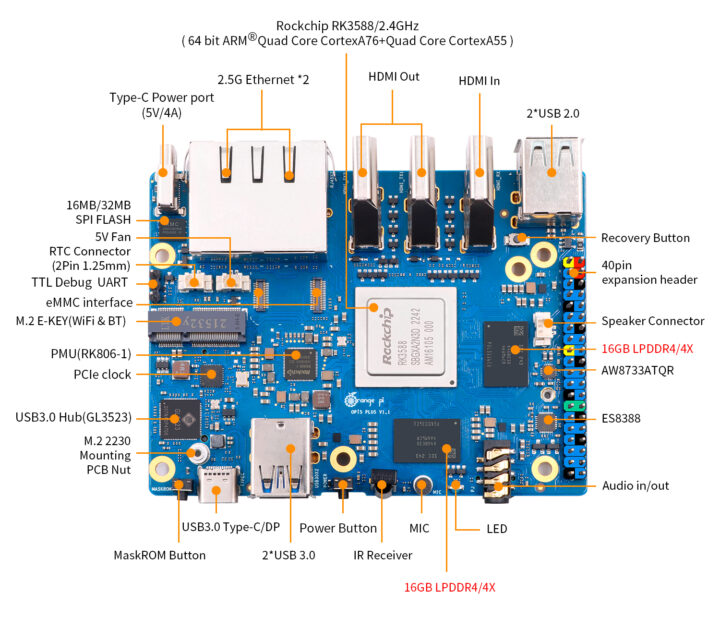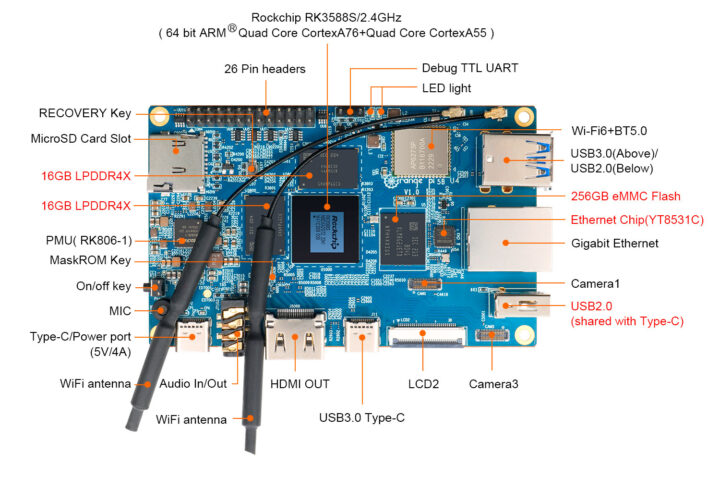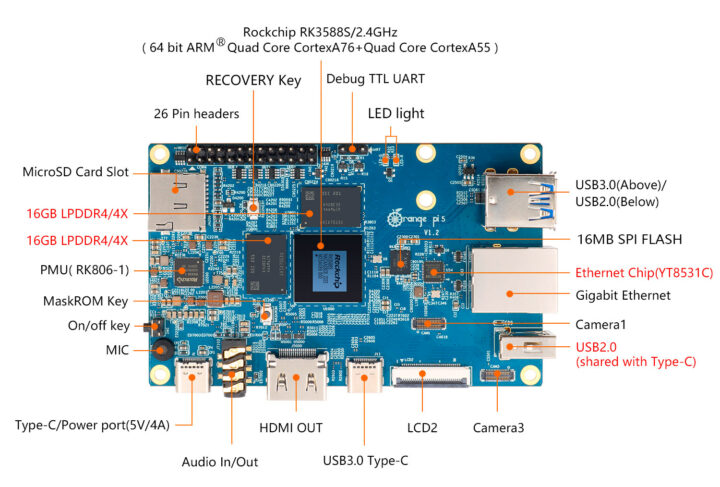Rockchip RK3588 SoC has long been advertised as supporting up to 32GB RAM, but the higher RAM capacity was mostly vaporware until Firefly introduced versions of their RK3588 boards and modules with 32GB RAM at the beginning of the summer.
Orange Pi has now unveiled its own 32GB RAM versions of the Orange Pi 5, Orange Pi 5B, and Orange Pi 5 Plus single board computers powered by the Rockchip RK3588S or RK3588 octa-core Cortex- A76/A55 SoC.

Besides the higher RAM capacity, nothing else has changed and for reference, here are the Orange Pi 5 Plus 32GB specifications:
Orange Pi 5 Plus specifications:
- SoC – Rockchip RK3588
- CPU – Octa-core processor with 4x Cortex-A76 cores @ up to 2.4 GHz, 4x Cortex-A55 cores @ up to 1.8 GHz
- Arm Mali-G610 MP4 GPU with support for OpenGL ES1.1/2.0/3.2, OpenCL 2.2, and Vulkan 1.2
- 6 TOPS AI accelerator with support for INT4/INT8/INT16/FP16 mixed operation
- VPU – 8Kp60 H.265/VP9/AVS2 10-bit decoder, 8Kp30 H.264 decoder, 4Kp60 AV1 decoder, 8Kp30 H.265/H.264 encoder
- System Memory – 32GB LPDDR4/4x
- Storage
- 16MB or 32MB QSPI NOR Flash
- MicroSD card slot
- eMMC flash socket for 32GB, 64GB, 128GB, or 256GB module
- M.2 2280 PCIe 3.0 x4 socket for NVMe SSDs up to 2,000 MB/s
- Video Output
- 2x HDMI 2.1 ports up to 8Kp60
- DisplayPort 1.4 up to 8Kp30 via USB-C port
- 2x 4-lane MIPI DSI connector up to 4Kp60
- 6-pin FPC socket for touchscreen
- Video Input
- Camera I/F – 4-lane MIPI CSI connector
- HDMI 2.0 input up to 4Kp60
- Audio
- ES8388 audio codec, AWINIC AW8733ATQR audio amplifier
- 3.5mm audio jack with headphone and microphone support
- Onboard MIC
- Support for HDMI 2.1 eARC
- Speaker connector
- Networking
- 2x 2.5GbE RJ45 ports via RTL8125BG controllers
- Optional WiFi and Bluetooth via M.2 module
- USB – 2x USB 3.0 ports, 1x USB 3.1 Gen 1 (5 Gbps) Type-C port, 2x USB 2.0 ports
- Expansion
- 40-pin header with GPIO, UART, I2C, SPI, CAN, I2S, PDM, AUDDSM, SDIO, PWM
- M.2 Key-M socket (PCIe 3.0 x4) for 2280 NVMe SSDs, or other PCIe 2280 modules (e.g. AI accelerators)
- M.2 Key-E socket (PCIe 2.0 x1/PCM/UART/USB2.0) for 2230 modules such as WiFi 6 and Bluetooth modules
- Debugging – 3-pin UART header for serial console
- Misc
- Power, MaskROM, and Recovery buttons
- Power LED, status LED, RGB LED
- IR receiver
- 5V fan connector
- 2-pin connector for RTC backup battery
- Power Supply
- 5V/4A via USB Type-C port
- RK806-1 PMU
- Dimensions – 100 x 70 mm (Slightly wider than Orange Pi 5B)
- Weight – 86.5 grams

32GB RAM on Rockchip RK3588 used to be prohibitively expensive explaining why manufacturers would not initially offer this option, but it has come down in price quite a lot with Orange Pi offering the following pricing:
- $159 for Orange Pi 5 with 32GB RAM on Aliexpress or Amazon
- $179 for Orange Pi 5B with 32GB RAM and 256GB eMMC flash on Aliexpress or Amazon
- $179 for Orange Pi 5 Plus with 32GB RAM on Aliexpress or Amazon
Note those are pre-orders with shipping scheduled to start by October 31 and shipping is not included. The boards are a bit more expensive on Amazon due to the extra/higher fees. The biggest competitors to the RK3588 boards with 32GB RAM may be the Intel Processor N100 mini PCs or motherboards which look to support 32GB RAM even though the CPU is only advertised up to 16GB on Intel Ark. That’s unless you need some specific features such as GPIOs, HDMI input, LCD and/or MIPI CSI camera interfaces.


Jean-Luc started CNX Software in 2010 as a part-time endeavor, before quitting his job as a software engineering manager, and starting to write daily news, and reviews full time later in 2011.
Support CNX Software! Donate via cryptocurrencies, become a Patron on Patreon, or purchase goods on Amazon or Aliexpress




